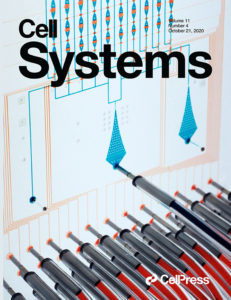Milestones in scientific discovery are often made possible by technological breakthroughs. Inventions such as the telescope, the microscope, and X-ray diffraction, have enabled us to probe further and deeper into the macrocosm and microcosm. In the streets lab, we’re interested in applying lessons from mathematics, physics, and engineering, to invent tools that help us dissect and quantify complex biological systems. Our goal is to uncover laws that govern the interactions of molecules inside the cell and the interactions between cells in a tissue or organism, by making precision measurements on single cells. In pursuit of this goal, we exploit three core technologies in the lab; microfluidics, microscopy, and genomics (and whatever else we can find in the salvage bin at the loading dock).
MICROFLUIDICS
We use microfluidic devices that take advantage of integrated elastomeric valves. The microfluidic valve is a three terminal component in which a control pressure on one terminal regulates the fluidic current through the other two terminals. In this way the microfluidic valve is the fluidic analog of the transistor in electronic circuits. Extending this analogy, we design and fabricate integrated microfluidic circuits for the execution of highly parallel chemical and biological processes. These systems provide precise liquid handling, deft manipulation of single cells, and high-throughput experimentation. Unfortunately we still haven’t been able to fit our whole lab on a chip yet. See our Biomicrofluidics review and our Current Opinion in Biotechnology for more information about microfluidics.
MICROSCOPY
We are interested in developing nonlinear optical microscopy for quantitative imaging of cells and tissue. The microscope was the original single cell technology. Now that we have powerful computational tools to process digital images, we can extract quantitative single-cell information from our specimens with tremendous sensitivity and specificity. In our lab, we aim to develop new imaging techniques to improve quantitative measurement of biological systems. Take a look at our Analytical Chemistry feature article and our Analyst minireview to learn more about imaging cells with nonlinear optical microscopy.
SINGLE-CELL GENOMICS
High-throughput DNA sequencing has revolutionized the way we do biology. In the streets lab we’re interested in creating new molecular techniques to extract and analyze genetic material in single cells. We take advantage of microfluidic devices to implement these protocols and facilitate single-cell analysis. These integrated microfluidic devices are especially useful for coupling high-resolution microscopy with single-cell genomic measurements. See our manuscripts describing Microfluidic Cell Barcoding and Sequencing (µCB-seq) and Microfludic DNA Adenine Methyltransferase Ddentification (µDamID) for examples of imaging and sequencing single cells with microfluidics.

